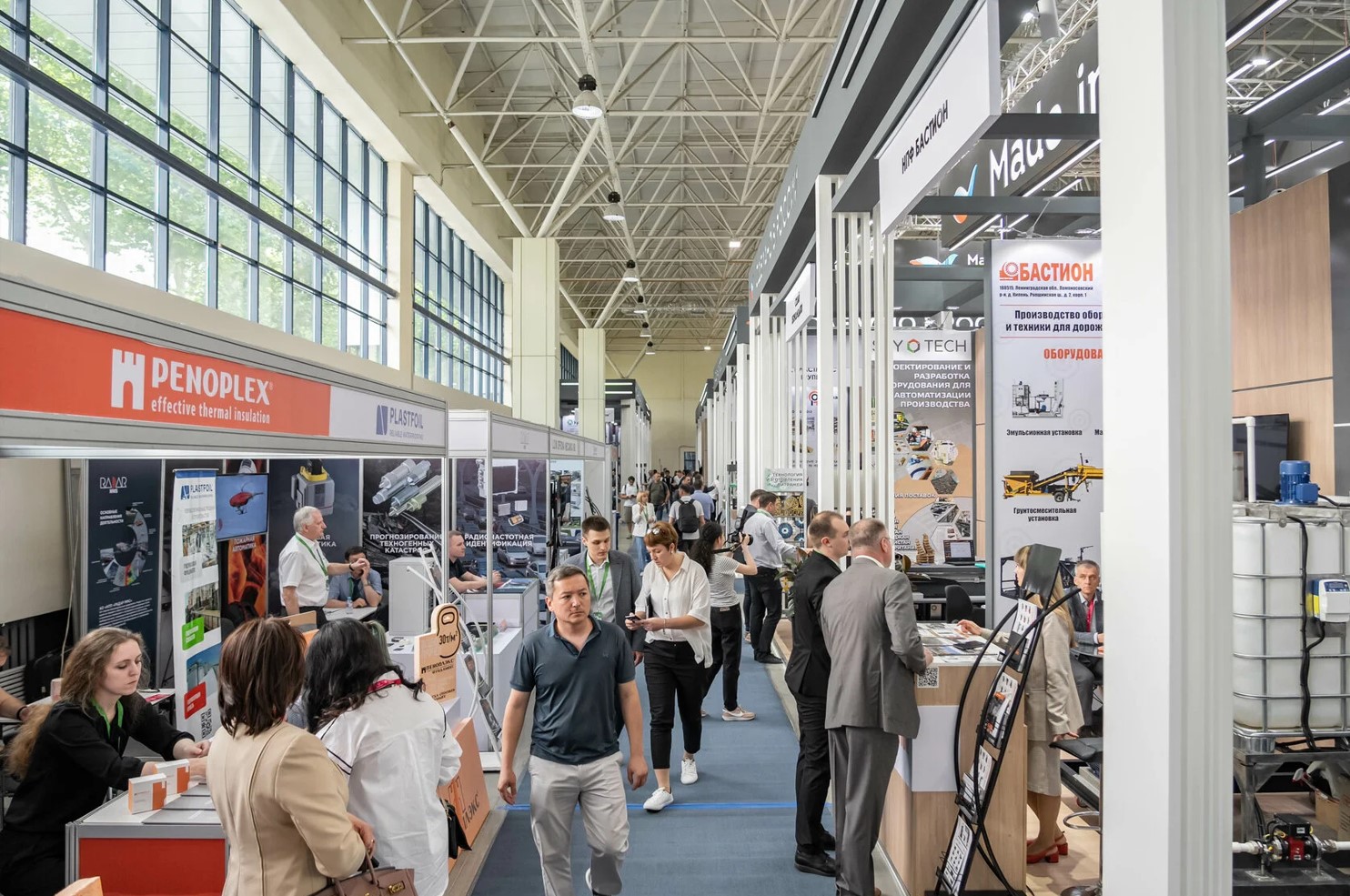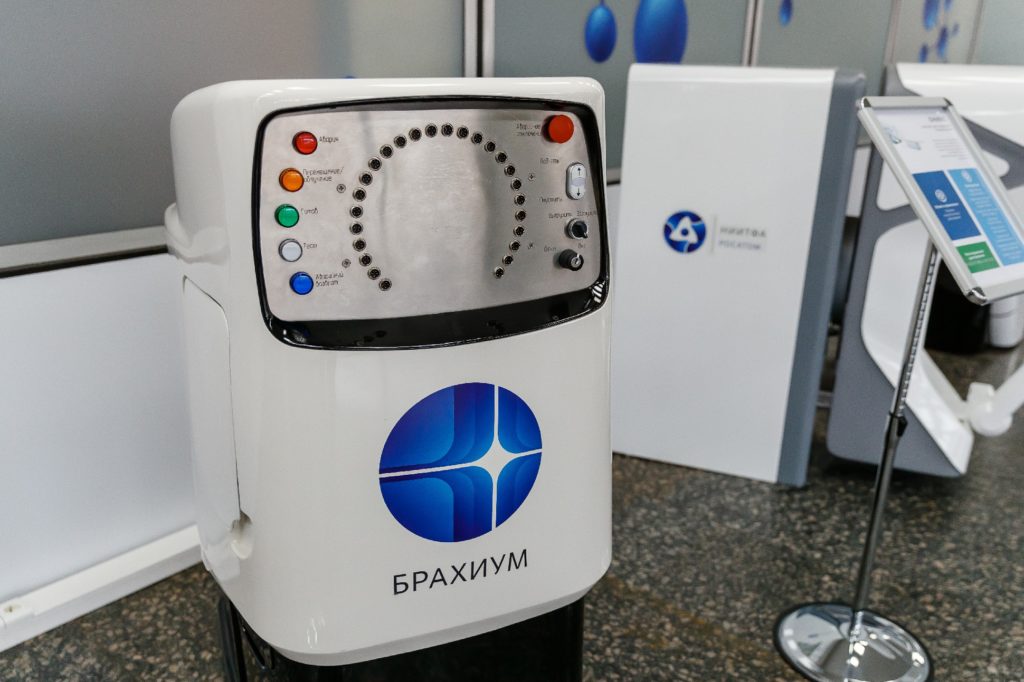
INNOPROM: New Horizons of Collaboration
back to contentsIn late April, Tashkent hosted INNOPROM. Central Asia International Industrial Trade Fair attended by over 10,000 visitors from 24 countries. Rosatom presented advanced technologies and products in nuclear medicine, digitalization, wind power, and energy storage.
Nuclear medicine makes it possible to early diagnose and successfully treat cancer, rheumatology, endocrinology and other diseases. Rosatom is the world’s Top 5 supplier of medical isotopes, such as iodine‑131, lutetium‑177, molybdenum‑99, and samarium‑153. Rosatom also produces medical equipment for radiation therapy and brachytherapy, and builds nuclear medicine centers and multi-purpose irradiation centers for sterilization of medical devices and treatment of foods.
Radiation healthcare technologies took a special place at Rosatom’s booth at INNOPROM. Presented at the booth was Brachyum gamma therapy system that attracted great interest among the visitors. Brachytherapy is a radiation therapy method that uses a sealed radiation source placed inside or next to the cancer-affected area. “This system stems logically from Rosatom’s competencies in the production of gamma ray treatment devices. It is a completely new model made to have a competitive edge in today’s global market,” Igor Obrubov, CEO of Rusatom Healthcare (part of Rosatom), told the Uzbekistan National News Agency (UzA) in an interview.
Brachyum is designed to treat cancers localized in the pelvic organs, breast, esophagus, nasopharynx and oral cavity, that is, any part of the body that can be reached through natural routes.
“This brachytherapy system works as follows: it uses two radiation-emitting sources, cobalt‑60 and iridium radioisotopes. They are kept in a container inside the device. A capsule carrying the radiation source is delivered to the tumor with a system of threads and is fixed there with applicators, and then radiation begins to destroy cancer cells,” Igor Obrubov explained. This is a minimally invasive procedure that requires no surgery but has a good therapeutic effect. Brachytherapy can be used both independently and in combination with other procedures, such as surgery.
Brachyum is fitted with an advanced dosimetry system that minimizes the probability of error and has applicators compatible with visual diagnostic, CT and MRI devices. Its 3D radiation therapy planning system helps create a 3D model of the tumor for more precise radiation targeting.
“I first saw Brachyum at Atomexpo 2022 held in Sochi last November, and I was amazed by its capabilities. The system is not inferior to foreign counterparts in terms of its functionality, but 30 % cheaper,” said Ilham Sadikov, Director of the Uzbekistan Academy of Sciences Institute of Nuclear Physics.

Brachyum has been installed in four hospitals in Russia. Two hundred people have received treatment, and the doctors appreciated the results very much. The plans are to install Brachyum in six more clinics by the end of the year. “Uzbekistan is considering the purchase of medical equipment; the tenders are underway, and we plan to participate in them,” Igor Obrubov said.
Rosatom also presented Tianox, an unparalleled nitric oxide therapy machine for the treatment of pre-capillary pulmonary hypertension in adults and children, including newborns. Tianox is used in cardiac surgery, intensive care, neonatology, pulmonology, gynecology and rehabilitation. What makes this machine unique is that nitrogen monoxide inhaled by the patients is synthesized right during the therapeutic procedure, in a gas discharge at room temperature. For this purpose, the machine uses air from the room where it is installed. It needs no gas cylinders and thus greatly increases the availability of such treatment.
“We are planning some joint healthcare projects with our partners from Uzbekistan, such as the development of nuclear medicine centers that will use Rosatom’s radiopharmaceuticals and equipment, and training of medical personnel for them,” Igor Obrubov shared plans.
Power industry and digitalization
INNOPROM visitors showed great interest in Rosatom’s power industry solutions, such as, for example, a staff training simulator and digital twins of power facilities. The simulators help provide onboarding training to new employees of thermal and hydro power plants and nuclear power plants with VVER reactors.
Rosatom also demonstrated its new digital product, a model-oriented engineering and mathematical modeling environment REPEAT (REal-time Platform for Engineering Automated Technologies). REPEAT allows building mathematical models of complex power facilities and processes, creating digital twins, and carrying out virtual tests of the equipment designed. REPEAT can be used to improve the efficiency of power facilities and reduce production costs, downtime and incidents.
Rosatom also presented its services to create a reliable digital infrastructure for industrial facilities in Central Asia. The digital ecosystem includes developers and integrators of sophisticated IT systems, infrastructure and cloud solutions, telecom operators, as well as an operator and integrator of one of the largest data center networks in Russia. These comprehensive services are based on advanced technologies and many years of experience in operating the most complex engineering facilities.
Visitors to Rosatom’s booth also had an opportunity to learn about Rosatom’s cooperation with the Central Asian countries in green energy: in addition to nuclear generation, Rosatom is ready to offer its solutions in wind power, energy storage and construction of hydro power plants.
Rosatom and Uzbekistan cooperate in several areas. For example, the first multi-purpose center for irradiation of agricultural products is being built in the country to treat different kinds of produce with ionizing radiation. Radiation breaks chemical bonds in pathogens and leaves no residual trace. This improves consumer properties of food products, increases their shelf life, and reduces losses in transit. This treatment method is absolutely safe — its safety was confirmed, among others, by the UN Food and Agriculture Organization (FAO) and the IAEA.
“The equipment for this center has been purchased. We plan to complete site surveys this year,” Igor Obrubov said.




